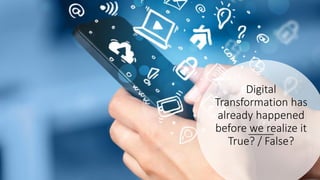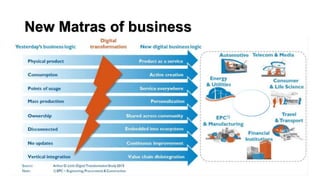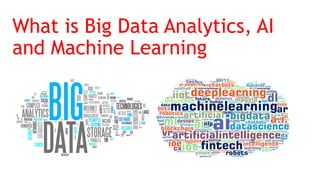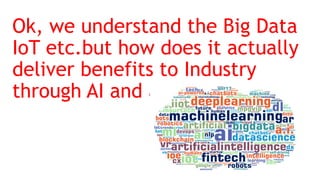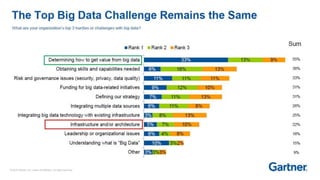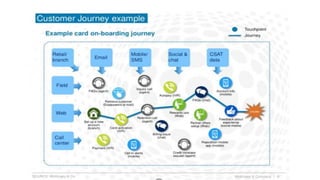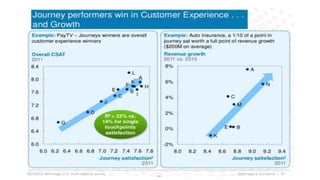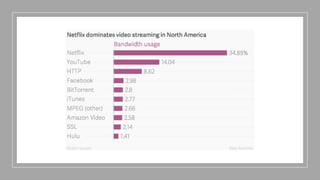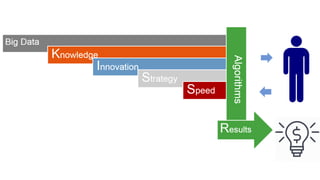ICMAI Pune Digital Transformation and Data Science
- 1. Acknowledgement and Disclaimer All the material in this deck is been prepared using resources published on public domain by various subject matter experts, Technical and domain experts and visual presentation experts. The deck is a collection of information published on web/internet sites, blogs and informative portals and it is prepared purely for educational awareness perspective with not for profit motive. I do not claim any copy right or ownerships IP whatsoever for any of the slides.
- 3. Digital Transformation has already happened before we realize it True? / False?
- 4. Who is the Customer – Virtual What is Identity – abc@xyz.com Where can you find him ? How do you promote / advertise your business What influences him to buy your goods/services Oh wow ! He has decided to purchase your goods/service. How does he pay ? How would you deliver your goods/services What if he finds some issues with your goods/services ? How do you interact with him to get his feedback on your goods/services. How do you make him buy more from your? How do you reward him for loyalty ? How do you make him your brand ambassador ? How do you find newer customers through existing ones ?
- 5. May be, its not just that…
- 6. May be, its not just that…
- 7. Unlike digitization, digitalization is the 'organizational process' or 'business process' of the technologically- induced change within industries, organizations, markets and branches., says Wikipedia.
- 8. Digital Customer Engagement Digital Business Operations Digital Business Foundation In a nutshell.. Digital Customer Journey “Digital transformation is the integration of digital technology into the core of a business’ function, from hierarchy to tools and operations to customer service.”
- 9. Ok,fine. So what’s the big deal about it ?
- 10. In a survey of 460 execs by IT analyst Gartner, 62 percent said they had a management initiative or transformation program to make their business more digital.
- 11. CEO’s top business priority
- 12. Worldwide spend on Technology Component of IT 2019 2020 Trends Datacenter System, 210 5.57% 202 5.21% ↓ Enterprise Software 431 11.44% 466 12.03% ↑ Devices 679 18.02% 689 17.78% ↑ IT Services 1030 27.34% 1079 27.85% ↔ Communication Services 1417 37.62% 1439 37.14% ↔ 3,767 3,875 * Source - Gartner All figures above are in xx Billions of US$ Worldwide spending on digital transformation technologies -- hardware, software, and services - - hit $1.3 trillion in 2017, according to IDC. The tech research company expects spending to almost double between now and 2021, when the total amount spent on digitalization globally will surpass $2.1 trillion.
- 13. Value Creation and Impact on Revenue The World Economic Forum suggests the value of digital transformation for both society and industry could reach $100 trillion by 2025.
- 14. Cumulative benefits of Digital Transformation Just four industries (automotive, consumer, electricity and logistics) have the potential to create $8.4 trillion in value for industry and $12.7 trillion in value for society between 2016 and 2025 (see Figure 1). Scaled up beyond these four industries, the size of the benefits could be as much as $100 trillion in ‘combined value’ for both industry and society by 2025.
- 15. It is not a technology trend anymore “Digital transformation is mainstream work in every business.” “It is something what you should have done yesterday.”
- 16. • Digitally networked things humans and market place • Departure from Traditional IT • Speed / Responsiveness • Build capability to profit from complex data • Super Intelligent and Fast decisions Few Common Denominators
- 17. One who creatively Multiplies each of these to solve business problems And the Leader Among them is..
- 18. It is about creating new eco systems
- 19. New Matras of business
- 20. Rapid Rise of new Business Models
- 21. What makes such Digital Transformations ‘Ahead of its generation’ for some organizations
- 22. When does digital transformation stop? It doesn't. Nothing of Value is ever Completed. In old days, projects came with finite timescale. In Digital age its about continuous improvement of something that is already good
- 24. Why these new technologies are such a big deal ?
- 26. Options and Models in Cloud Computing
- 28. …finding its Application to the Industry
- 30. Data Residency
- 32. It is also the CEO’s Choice
- 33. CIOs are happy as well
- 34. CIOs are happy as well
- 36. What is Big Data Analytics, AI and Machine Learning
- 37. Understanding the world of Data
- 40. Understanding the world of Data
- 41. Understanding the world of Data
- 42. What data we are talking about Date / Time Temperature Public news Social Media Mobile Market Research Campaign Trails Emails Location data Chats Sensors Clicks Video viewing/Streaming Video viewing - Pauses in Videos Images Media Video Uploads SYSTEMs Customer ID/Aadhar Public Identity Employee Identity Social Identity Marketing data CRM Campaign Supply Chain Procurement HR System Billing Sales Accounting Inventory Mgmt Workflow processing Core Systems Data Warehouses Four V’s lead to the Fifth V - Value
- 44. Traditional data Journey v/s Big Data Journey Traditional Data Journey Was finite Big Data Journey is Iterative
- 48. What is Internet of Things (IoT)
- 49. In Short IoT is an extension of Internet into the Physical World we live in (And an attempt to benefit from it)
- 50. IoT Technology is an Evolution IoT Business is a Revolution
- 54. Ok, we understand the Big Data IoT etc.but how does it actually deliver benefits to Industry through AI and analytics
- 58. Let us understand a simple Use Case of Customer Journey or Customer experience
- 68. Another Fascinating Use Case of NETFLIX
- 69. Netflix has over 100 million subscribers (& their data)
- 70. Netflix spent $100 million based on a prediction based on data analytics. (& it was a Smash hit exactly as predicted !)
- 71. • Netflix looks at data generated from over 40 million “plays” a day. It keeps a record of every time subscribers pause the action, rewind, or fast-forward. They track how many subscribers abandon a show entirely after watching for a few minutes. In addition they track the time of day when shows are watched, and on what devices they are watched on. • Netflix user account data provides verified personal information (sex, age, location), as well as preferences (viewing history, bookmarks, Facebook likes). • Having this wealth of detailed knowledge of Netflix subscribers, what they watch, and how they watch it allowed the company take the next step of creating content, but do it using intelligent data driven decisions. • The data collected by Netflix indicated there was a strong interest for a remake of the BBC miniseries House of Cards. These viewers also enjoyed movies by Kevin Spacey, and those directed by David Fincher. • Netflix determined that the overlap of these three areas would make House of Cards a successful entry into original programming. • The result: House of Cards is the most streamed piece of content in the United States and 40 other countries, according to Netflix. It is rated 9.1/10 from 180,816 users at IMDB. Netflix spent $100 million based on a prediction based on data analytics. (& it was a Smash hit exactly as predicted !)
- 77. Q & A
- 78. Thank you Presented by Niraj Vaidya contact.nyruj@gmail.com http://in.linkedin.com/in/nirajvaidya https://twitter.com/n_y_r_u_j



